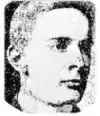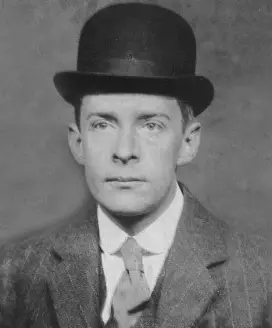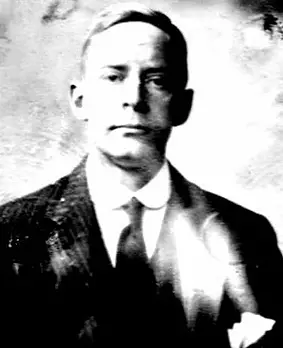Robert Williams Daniel
First Class passenger

He was“positive the first officer of the Titanic committed suicide by sending a bullet in his brain before the ship foundered. ‘I know it,’ he declared. ‘I was not more than ten feet away. I do not believe the stories that Capt. Smith ended his life. He stuck to his post to the last. He was a brave man. ”
Listed as “Daniel, Mr. Robert Williams” in Triumph and Tragedy (p.340 (7.)) this source gives further details as to his residence being Philadelphia, PA, age 27, having embarked at Southampton and travelling First Class. After the disaster he put a claim in for a “Champion French bulldog, Gamin de Pycombe -$750” (Triumph and Tragedy p.278). According to Elizabeth Gibbons "First Class passenger Robert Williams Daniel was a Philadelphia and Richmond, Virginia, banker who moved in the highest American social circles; he was a friend of John Jacob Astor, and when Astor was not among the survivors Vincent Astor went to Daniel at the Waldorf Astoria, searching for information on his father's last hours. Reporters from the New York Times were right behind Vincent Astor." (55.) His story is among only a few ‘happy endings’ that occurred as a result of the disaster when he met Mary Eloise Smith (another survivor whose husband had died) on the Carpathia, becoming good friends and eventually marrying in two years time (Titanic -Tibballs p.107 (5.)). Yet, he was married two more times afterward, later becoming a member of the state senate for Virginia. He died in 1940, aged 56. (Philip Hind, Encyclopedia Titanica (8.)).

Robert Williams Daniel, 1915, courtesy
the National Archives and Records
Administration/Mike Poirier (8.)
There is confusion over what lifeboat Daniel eventually ended up on. If he was in the water (as described in his account) then he would have found refuge on either collapsible A or B. But Triumph and Tragedy lists him as being in lifeboat 7 (p.340), while Encyclopedia Titanica mentions lifeboat 3 (Philip Hind, Encyclopedia Titanica (8.)).
According to Titanic –Tibballs “Daniel leapt from the sinking ship two minutes before she went down” (p.89). It is possible that a combination of all the above is correct, Daniels in the sea, then on board one of the collapsibles and then transferred into either 3, 4 or 7, in accord with Bill Wormstedt who writes that “Daniel appears to have been one of the survivors rescued in either in Collapsible A, B, or picked up by No. 4” (Bill Wormstedt, Shots in the Dark (12.) ). If so, then his location and timeframe makes is plausible that he may have witnessed an alleged suicide.
The April, 20, 1912 issue of The New York Times contains two accounts from Daniel concerning a suicide:
“He [Daniel] had remained to the end, he said, and gave an eerie reality to the last moments on the boat deck. ‘It didn’t seems to me that we were sinking, but the waters seemed rising up over us.’ Then he jumped, struggling among the ice-floes until rescued. He was articulate and adamant; it was Murdoch, he said, who had shot himself in the temple. ‘I was not more than ten feet away, I do not believe the stories that Captain Smith ended his life. He stuck to his post to the last. He was a brave man.’”
Another article on the same day reads: “Mr. Daniel said that he was positive the first officer of the Titanic committed suicide by sending a bullet in his brain before the ship foundered. ‘I know it,’ he declared. ‘I was not more than ten feet away. I do not believe the stories that Capt. Smith ended his life. He stuck to his post to the last. He was a brave man.’”
Elizabeth Gibbons notes a possible contradiction in the account:
"The contradiction is clear: if Daniel knew it was the First Officer who had shot himself then he would not need to state a "belief" that Captain Smith had not done so. Either Smith did or did not and Daniel, from ten feet away, should have been able to say so with certainty. Smith and Murdoch could not have been mistaken one for the other. Perhaps Daniel did see the suicide, or perhaps he did not; it is clear, however, that he did not know the officer. He connected Murdoch's name with the incident almost certainly because he heard it proposed on the Carpathia." (55.)
Daniel’s other eyewitnesses testimony includes another newspaper account:
“Not until the last five minutes did the awful realization come that the end was at hand. The lights became dim and went out, but we could see. Slowly, ever so slowly, the surface of the water seemed to come up towards us. So gradual was it that even after I had adjusted the life jacket about my body it seemed a dream. Deck after deck was submerged. There was no lurching or grinding or crunching. The Titanic simply settled. I was far up on one of the top decks when I jumped. About me were many others in the water. My bathrobe floated away, and it was icily cold. I struck out at once. I turned my head, and my first glance took in the people swarming on the Titanic’s deck. Hundreds were standing there helpless to ward off approaching death. I saw Captain Smith on the bridge. My eyes seemingly clung to him. The deck from which I had leapt was immersed. The water had risen slowly, and was now to the floor of the bridge. Then it was to Captain Smith’s waist. I saw him no more. He died a hero. The bows of the ship were far beneath the surface, and to me only the four monster funnels and the two masts were now visible. It was all over in an instant. The Titanic’s stern rose completely out of the water and went up 30, 40, 60 feet into the air. Then, with her body slanting at an angle of 45 degrees, slowly the Titanic slipped out of sight.” (Titanic –Tibballs, p.89 (5.))
This testifies to certain accuracy of statement as he recalls in great detail events that have been verified by general consensus. Rather than appeal to those who gave many heroic and unrealistic endings to Captain Smith, he also gives an unemotional statement of fact as to his last sighting of the Captain, this theme in all three of his accounts. It also gives his location in the water as being toward the forward end of the ship.

Robert W. Daniel passport picture 1916.
Courtesy NARA/Michael Poirier (8.)
Upon this evidence then, when he also said that he saw an officer shoot himself “from ten feet away” and that “It must be Murdoch,” his other evidence, reputation and location does not betray a man prone to speculation or rumour. Yet, George Behe writes that Daniel’s suicide account is “untrue” because he “was nowhere near First Officer Murdoch (or any other officer) at the time of the suicide. Instead, Daniel was seen near the Titanic’s stern by Thomas Dillon and subsequently jumped into the sea from that location as the stern rose skyward. Daniel’s own account corroborates Dillon's story.” (George Behe, First Officer Murdoch and the ‘Dalbeattie Defense’ (11.))
Providing a balance, Bill Wormstedt writes: “Robert Williams Daniel story is partially corroborated by Jack Thayer, who saw him near the bow of the ship after all the lifeboats had gone, and by Trimmer Patrick Dillon who saw him jump near the stern of the ship just before the final plunge. It is possible that Daniel could have witnessed the shooting/suicide before heading aft.” (Bill Wormstedt, Shots in the Dark (12.) )
Daniel apparently didn’t know Murdoch personally, but, according to the The New York Times he was “articulate and adamant; it was Murdoch, he said, who had shot himself in the temple.”
Elizabeth Gibbons also believes the press did not like Daniels:
"The New York Times printed the interview but a reporter added a curious observation. At a time when survivors were being lauded for heroism and self sacrifice, and the dead were receiving lavish praise, a stinging sentence was aimed at a man who had, after all, said he had gone down with the ship and behaved with self discipline: 'Mr. Daniel seemed little the worse for his experience, and in the afternoon entertained a score or more of his friends at the Waldorf.'... The disdain is obvious. Something in the man's manner aroused the hostility of the press and encouraged disbelief." (55.)
Doubt over Daniel's precise location means that while the account itself seems coherent there is some element of doubt.
Verdict: